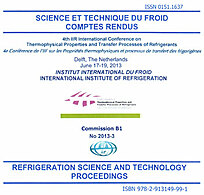
Document IIF
Évaluation expérimentale d'un mini-système à cycle de vapeur pour des applications de refroidissement de composants électroniques: le R1234yf comparé au R134a.
Experimental evaluation of a mini-VCS for electronic cooling applications: R1234yf vs R134a.
Numéro : pap. n. TP-049
Auteurs : MANCIN S., ZILIO C., ROSSETTO L.
Résumé
This paper compares the performance of R1234yf and R134a used as working fluids in a mini Vapour Cycle System (VCS) for electronic thermal management of aeronautical packaging. The water cooled miniature scale refrigeration system implements a new concept oil-free linear compressor prototype. The compressor operates at constant speed while its capacity can be varied by controlling the piston stroke. The experimental measurements were carried out at constant evaporation temperature of 15°C and varying the condensation levels permitted to compare the performance of the mini VCS, operating with R134a and R1234yf, in terms of cooling capacity and COP. Furthermore, particular attention was dedicated to the cold plate design, which had to meet the requirements established by the aeronautical standards. The cold plate was equipped with 15 thermocouples in order to analyze the wall temperatures distribution. In this way, it was possible to directly compare the flow boiling heat transfer behaviors of the two fluids under the same operating conditions.
Documents disponibles
Format PDF
Pages : 8 p.
Disponible
Prix public
20 €
Prix membre*
Gratuit
* meilleur tarif applicable selon le type d'adhésion (voir le détail des avantages des adhésions individuelles et collectives)
Détails
- Titre original : Experimental evaluation of a mini-VCS for electronic cooling applications: R1234yf vs R134a.
- Identifiant de la fiche : 30008272
- Langues : Anglais
- Source : 4th IIR Conference on Thermophysical Properties and Transfer Processes of Refrigerants
- Date d'édition : 17/06/2013
Liens
Voir d'autres communications du même compte rendu (69)
Voir le compte rendu de la conférence
Indexation
-
Thèmes :
Compresseurs;
HFC;
Autres applications industrielles - Mots-clés : R134a; R1234yf; Électronique; Refroidissement; Miniaturisation; Experimentation; Compresseur sec
-
Mini vapour cycle system for high density elect...
- Auteurs : MANCIN S., ZILIO C., ROSSETTO L.
- Date : 16/07/2012
- Langues : Anglais
- Source : 2012 Purdue Conferences. 14th International Refrigeration and Air-Conditioning Conference at Purdue.
- Formats : PDF
Voir la fiche
-
Mini vapor cycle system for high density electr...
- Auteurs : MANCIN S., ZILIO C., RIGHETTI G., et al.
- Date : 06/2013
- Langues : Anglais
- Source : International Journal of Refrigeration - Revue Internationale du Froid - vol. 36 - n. 4
- Formats : PDF
Voir la fiche
-
Development of a cooling unit for high ambient ...
- Auteurs : RIBEIRO G. B.
- Date : 16/07/2012
- Langues : Anglais
- Source : 2012 Purdue Conferences. 14th International Refrigeration and Air-Conditioning Conference at Purdue.
- Formats : PDF
Voir la fiche
-
A comprehensive model of a miniature-scale line...
- Auteurs : BRADSHAW C. R., GROLL E. A., GARIMELLA S. V.
- Date : 01/2011
- Langues : Anglais
- Source : International Journal of Refrigeration - Revue Internationale du Froid - vol. 34 - n. 1
- Formats : PDF
Voir la fiche
-
A compact reverse Rankine Cycle combines surfac...
- Auteurs : CARNEIRO M. V. P., PROVENSI A., CAVICCHIOLI P., PEREIRA M., BARBOSA J. R. Jr
- Date : 31/07/2020
- Langues : Anglais
- Source : IIR Rankine Conference 2020.
- Formats : PDF
Voir la fiche
